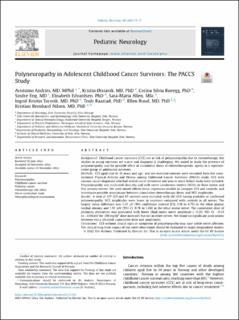| dc.contributor.author | Andries, Aristomo | |
| dc.contributor.author | Ørstavik, Kristin | |
| dc.contributor.author | Rueegg, Corina Silvia | |
| dc.contributor.author | Eng, Sindre | |
| dc.contributor.author | Edvardsen, Elisabeth | |
| dc.contributor.author | Torsvik, Ingrid Kristin | |
| dc.contributor.author | Raastad, Truls | |
| dc.contributor.author | Ruud, Ellen | |
| dc.contributor.author | Nilsen, Kristian Bernhard | |
| dc.contributor.author | Allen, Sara-Maria | |
| dc.date.accessioned | 2023-03-02T13:56:50Z | |
| dc.date.available | 2023-03-02T13:56:50Z | |
| dc.date.created | 2023-01-06T14:19:03Z | |
| dc.date.issued | 2022 | |
| dc.identifier.citation | Pediatric Neurology. 2023, 140(Mars 2023), Side 9-17. | en_US |
| dc.identifier.issn | 0887-8994 | |
| dc.identifier.uri | https://hdl.handle.net/11250/3055440 | |
| dc.description | This is an open access article under the CC BY license (http://creativecommons.org/licenses/by/4.0/). | en_US |
| dc.description.abstract | Background: Childhood cancer survivors (CCS) are at risk of polyneuropathy due to chemotherapy, but studies in young survivors are scarce and diagnosis is challenging. We aimed to study the presence of polyneuropathy and the possible effect of cumulative doses of chemotherapeutic agents in a representative group of adolescent survivors.
Methods: CCS aged nine to 18 years and age- and sex-matched controls were recruited from the cross-sectional Physical Activity and Fitness among Childhood Cancer Survivors (PACCS) study. CCS with various cancer diagnoses who had ended cancer treatment one year or more before study were included. Polyneuropathy was evaluated clinically and with nerve conduction studies (NCSs) in three motor and five sensory nerves. We used mixed-effects linear regression models to compare CCS and controls, and investigate possible associations between cumulative chemotherapy doses and NCS amplitudes.
Results: A total of 127 CCS and 87 controls were included, with 14% CCS having probable or confirmed polyneuropathy. NCS amplitudes were lower in survivors compared with controls in all nerves. The largest mean difference was 3.47 μV (95% confidence interval [CI], 2.18 to 4.75) in the tibial plantar medial sensory and 1.91 mV (95% CI, 0.78 to 3.04) in the tibial motor nerve. The cumulative dose of platinum derivatives was associated with lower tibial motor nerve amplitude (−0.20; 95% CI, −0.35 to −0.04 mV for 100 mg/m2 dose increase) but not in other nerves. We found no significant associations between vinca alkaloids cumulative dose and amplitudes.
Conclusions: CCS without clinical signs or symptoms of polyneuropathy may have subtle nerve affection. The clinical long-term impact of this novel observation should be evaluated in larger, longitudinal studies. | en_US |
| dc.language.iso | eng | en_US |
| dc.subject | chemotherapy side effect | en_US |
| dc.subject | childhood cancer survivor | en_US |
| dc.subject | nerve conduction study | en_US |
| dc.subject | neurophysiological examination | en_US |
| dc.subject | pediatric cancer | en_US |
| dc.subject | polyneuropathy | en_US |
| dc.title | Polyneuropathy in adolescent childhood cancer survivors: The PACCS study | en_US |
| dc.type | Peer reviewed | en_US |
| dc.type | Journal article | en_US |
| dc.description.version | publishedVersion | en_US |
| dc.rights.holder | © 2022 The Authors | en_US |
| dc.source.pagenumber | 9-17 | en_US |
| dc.source.volume | 140 | en_US |
| dc.source.journal | Pediatric Neurology | en_US |
| dc.identifier.doi | 10.1016/j.pediatrneurol.2022.11.012 | |
| dc.identifier.cristin | 2102199 | |
| dc.description.localcode | Institutt for fysisk prestasjonsevne / Department of Physical Performance | en_US |
| cristin.ispublished | true | |
| cristin.fulltext | postprint | |
| cristin.qualitycode | 1 | |
